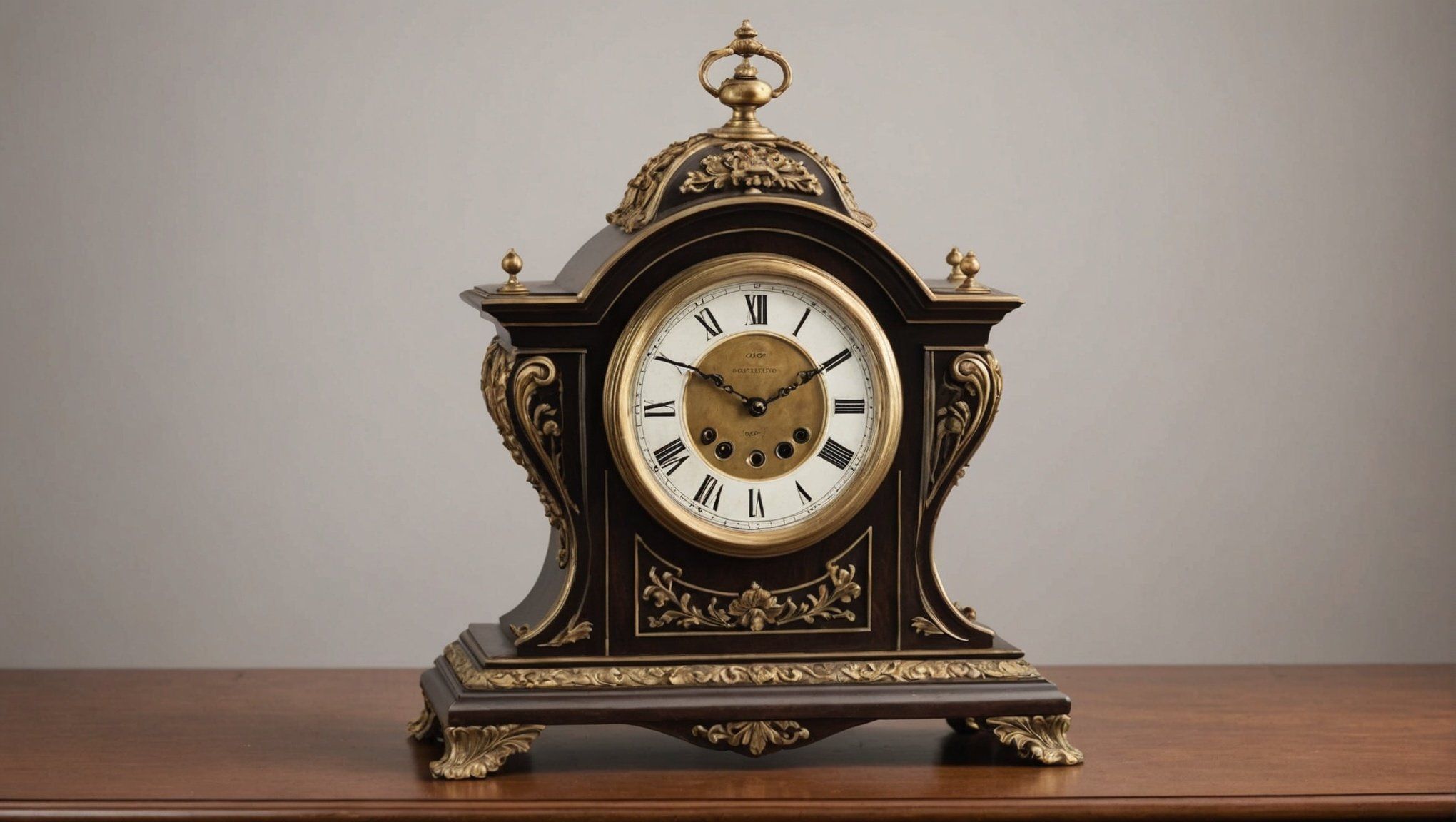Antique mantel clocks blend elegance and history, capturing the essence of their time through intricate craftsmanship. Each piece tells a unique story, from skilled artisans to the modern collector’s sanctuary. Discover the breathtaking designs of notable makers like Erwin Sattler and Hermle, and learn how these timeless treasures can enrich your space. Whether for appreciation or investment, these clocks offer beauty and a slice of history to cherish.
Discovering Antique Mantel Clocks
Antique mantel clocks are more than just timekeeping devices; they are exquisite representations of history and craftsmanship, deeply embedded in cultural narratives. These timepieces, often revered for their aesthetic appeal, tell stories of the epochs they were crafted in, while showcasing the artistry and technological advances of their times.
This might interest you : Illuminate your home: discover the candle project in Qatar
Historical Significance and Cultural Context
The historical significance of antel clocks extends far beyond their functional purpose. Crafted mostly between the 18th and 19th centuries, these clocks reflect the changing tastes and artistic movements of their times. For instance, during the French Empire period (1804-1815), mantel clocks became canvases for opulent designs, often incorporating classical motifs and figures. This time coincided with significant advancements in decorative arts and horology, mirroring the grandeur of Napoleon Bonaparte’s reign.
Notable examples from this era include chariot clocks, which combined clockmaking with intricate sculpture, often featuring mythical deities such as Apollo as part of their design. These marvels were not just timekeepers but symbols of status, often gracing the homes of European aristocracy and still admired in prestigious collections today, such as at Buckingham Palace and the Hermitage Museum.
This might interest you : Unlock your gaming potential with the perfect case opening hub
Craftsmanship and Artisanal Techniques
The craftsmanship behind antique mantel clocks is truly remarkable. These clocks often boast ornate designs, utilizing materials like gilt bronze and marble, which highlights the skill of artisans who were often trained in sculpting, chasing, and gilding. The French clockmaking hub of Paris was renowned for these creations, where master artisans worked alongside clockmakers to produce pieces that were not only functional but also visual spectacles.
Each mantel clock tells a unique story—a reflection of its time and place, and the individuals who crafted it. The detailing in these clocks speaks volumes about the era’s technical advancements and artistic achievements. Celebrated artisans like Antoine-André Ravrio and Pierre-Philippe Thomire have left behind an impressive legacy that is still revered by collectors today.
Exploring the Collection
For those seeking an immersive dive into the world of antique mantel clocks, the incredible collection of antique mantel clocks at La Pendulerie offers a splendid window into history. Styles ranging from Louis XVI to French Empire provide a kaleidoscope of design evolution through the centuries. Clocks bearing intricate sculpting and opulent gilding capture the essence of their respective eras, making each piece a culturally rich artifact.
Collecting and decorating with these antique clocks is not just about aesthetics; it is about preserving a piece of history and celebrating the enduring allure of traditional craftsmanship. With each tick, these clocks remind us of the timeless beauty ensconced within their frames, making them coveted items among enthusiasts and collectors alike.
Styles and Features of Antique Mantel Clocks
Popular Styles of Mantel Clocks
Antique mantel clocks boast a variety of ornate clock designs, each reflecting different historical periods and artistic influences. Among the most celebrated styles are the French Empire and Louis XVI periods. The allure of these clocks often lies in their intricate craftsmanship, with artisans blending aesthetics with functionality to create pieces that are both timekeepers and works of art. The French Empire style is characterized by grandiosity and a strong sense of neoclassical elegance, often using motifs inspired by ancient Rome and Egypt. Bronze statues, frescoed dials, and luxurious materials are hallmarks of this era’s mantel clocks.
In contrast, Louis XVI styles have a more delicate and refined aesthetic, drawing heavily from classical antiquity while incorporating geometrical forms and natural motifs like flowers and leaves. These clocks often feature a symmetrical balance and fine detailing, underscoring the grace and subtlety of their design.
Unique Features That Define Antique Clocks
The defining characteristics of antique mantel clocks go beyond mere ornamentation. A significant feature is the mechanical precision inherent in antique clock movements, which were often crafted as much for their accuracy as for their beauty. Many clocks from the French Empire or Louis XVI periods include unique mechanisms, such as the striking mechanism seen in pieces like the Circa 189 French 4 Glass Mantel Clock, which chimes on the hour and half-hour. This intricate mechanism not only showcases the meticulous craftsmanship of antique clocks but also exemplifies the advancements in horology during their respective eras.
Additionally, antique clocks often come with artistically designed dials, commonly made of enamel or painted ceramics, adding to their visual and historical appeal. The use of precious metals, fine wood inlays, and sometimes porcelain decorations further sets antique mantel clocks apart as true collectibles.
Comparison of French Empire and Louis XVI Styles
The French Empire and Louis XVI styles occupy prominent positions in the history of antique mantel clocks, each offering distinct visual and functional charms. While the French Empire clocks, created during Napoleon Bonaparte’s reign, are synonymous with opulence and theatricality—highlighting the era’s fascination with classical deities and historic themes—Louis XVI pieces exude a subtle elegance that aligns with the Rococo and Neoclassical movements in art.
When comparing the two, it is clear that French Empire clocks often embody a more robust and bold presence, frequently adorned with mythological figures and stories that speak to the storytelling through antique clocks. Conversely, Louis XVI clocks tend to emphasize symmetry and proportion, embodying more subdued grandeur through floral patterns and linear motifs.
These stylistic differences not only reflect the cultural and political influences of the times in which they were made but also underscore the role of clocks as artistic movements reflected in clock design. Collectors and enthusiasts appreciate these variations, as they offer a window into the past and the iconic timepieces in history that continue to fascinate with their timeless beauty.
In essence, the exploration of antique mantel clocks offers both an aesthetic and historical journey—each piece telling a story of its era in its unique style and design.
Collecting and Caring for Antique Clocks
Essential Tips for Starting an Antique Clock Collection
For those fascinated by the allure of antique clocks, starting a collection can be an exciting journey into history and artistry. When considering the acquisition of vintage timepieces, begin by identifying your interest in specific styles or periods, such as the French Empire or Rococo periods, known for their ornate clock designs. Understanding the historical significance of these eras can enhance your appreciation and help you make informed decisions.
Research is crucial; take time to learn about the different types of clocks, their mechanical intricacies, and the renowned clockmakers, like Antoine-André Ravrio or Pierre-Philippe Thomire. Visiting exhibitions or museums with notable antique clock collections can provide inspiration and context. Consider attending auctions or antique fairs to gain firsthand experience with the market and to speak with experts about the unique qualities of specific pieces. Remember, authenticity is key; ensure any antique mantel clock you consider for your collection has verifiable provenance and authenticity certificates. This not only protects your investment but also assures its historical integrity.
Guidelines for Assessing Clock Value and Authenticity
Determining the value of an antique clock involves several factors. One primary aspect is the condition—check for any restorations or repairs that might affect its worth. Examine materials like gilt bronze or marble, which can indicate the clock’s quality and craftsmanship. The presence of a maker’s signature or hallmark is also significant, often denoting a piece’s origin and authenticity.
Consult with reputable appraisers or dealers who specialize in antique timepieces. They can offer insights into the current market trends and the desirability of specific models. Seek documentation and history associated with the clock, as these elements can dramatically affect its value. Additionally, understanding the clock’s mechanism—whether it includes original components like the face, hands, or movement—can impact its appraisal.
Maintenance and Restoration Tips to Preserve Antique Timepieces
Proper care is essential to preserve the beauty and functionality of antique clocks. Begin with regular cleaning using appropriate products that do not damage the materials, such as a soft cloth for dusting and specialized cleaners for metals. Position clocks away from direct sunlight and fluctuating temperatures to prevent damage to delicate components and finishes.
Should restoration be necessary, enlist professionals who specialize in antique clocks. This ensures that any repairs or replacements are consistent with the clock’s original design and technique. Restorers familiar with the craftsmanship of renowned clockmakers can adeptly handle intricate tasks while maintaining historical accuracy.
Be mindful of the intricate movement mechanism. Regular servicing by a qualified horologist will ensure that your clock operates smoothly and retains its value. If your clock features complex functions like striking or chiming, these require particular attention to maintain their harmony and precision.
Clock collecting is a rewarding pursuit, offering both aesthetic pleasure and a tangible connection to the past. With careful research, thoughtful acquisition, and dedicated maintenance, you can build a collection that celebrates the rich legacy of clockmaking artistry.






